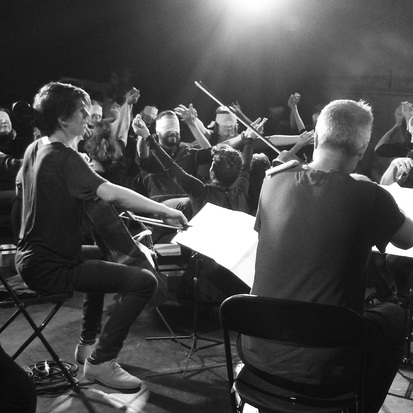| On the final day of Leake Street’s six-week VAULT festival, I took to the tunnel to have my senses livened by some classical music courtesy of a secret BitterSuite performance. Immersive theatre and dining experiences are now fairly common place on the urban social scene, but immersive concerts less so. Established by musician and composer Steph Singer, the BitterSuite collective is inspired by synesthesia and psychology and designed to make audiences really feel the music. The concert offered unique one-to-one experiences where each audience member was led through a choreographed sensory experience to Debussy, performed by Phaedra Ensemble instrumentalists. |
'Experience Debussy’s bewilderingly colourful quartet like never before through taste, touch, smell and movement.'
The sensory experience started with the audience removing their coats and shoes before being given a Turkish delight and taking their seats around the musicians next to a BitterSuite performer. On each chair sat a box reading ‘Open Me’, followed by ‘Smell me’. The fragrance, by Sarah McCartney, resembled Mitsouko, and was a reference to fragrances used on curtains in Parisian theatres to cover urban smells of decay. As the musicians began playing, the BitterSuite performers made synchronised movements - crossing their legs the same way and moving their heads in the same directions, taking their cues from the music. This was a precursor for things to come, introducing the notion that body movements would be shaped by the music.
Before long blindfolds were whipped out and placed over audience eyes, removing any self-consciousness that comes with the ability to see and be seen. What followed was a sequence of touch, smells and tastes, the latter designed by Adam Thomason. Popping candy exploded on tongues to the tune of energetic and erratic rhythms, scented scarves were draped over faces, hugs and musical massages galore were administered and swaying and dancing energised the concert room. When a lime marshmallow coated in citric acid hit my tongue I experienced the bitter in BitterSuite. Thought was given to Debussy’s writing; written for both indoors and outdoors the performers simulated changing climates by creating draughts in front of each audience member and even spritzing them!
Smiles and laughter were the result, making the audience participants in the music themselves. Throughout the concert, emotions ranging from apprehension and uncertainty to security and peacefulness. Such hyper stimulation was designed to intensify the listening experience, to stop brains whirring and to instead allow the audience to experience the music with the body.
The intimate performance went very quickly, and I found myself not wanting it to end. Once blindfolds had been removed instantaneous chatter and laughter followed; there was a carefree openness and need to ‘debrief’, to release thoughts on the experience. My relaxed state convinced me that the experience had been successful in making me ‘present’, stopping any previous thought processes or preoccupations.
Before long blindfolds were whipped out and placed over audience eyes, removing any self-consciousness that comes with the ability to see and be seen. What followed was a sequence of touch, smells and tastes, the latter designed by Adam Thomason. Popping candy exploded on tongues to the tune of energetic and erratic rhythms, scented scarves were draped over faces, hugs and musical massages galore were administered and swaying and dancing energised the concert room. When a lime marshmallow coated in citric acid hit my tongue I experienced the bitter in BitterSuite. Thought was given to Debussy’s writing; written for both indoors and outdoors the performers simulated changing climates by creating draughts in front of each audience member and even spritzing them!
Smiles and laughter were the result, making the audience participants in the music themselves. Throughout the concert, emotions ranging from apprehension and uncertainty to security and peacefulness. Such hyper stimulation was designed to intensify the listening experience, to stop brains whirring and to instead allow the audience to experience the music with the body.
The intimate performance went very quickly, and I found myself not wanting it to end. Once blindfolds had been removed instantaneous chatter and laughter followed; there was a carefree openness and need to ‘debrief’, to release thoughts on the experience. My relaxed state convinced me that the experience had been successful in making me ‘present’, stopping any previous thought processes or preoccupations.
I stuck around after my performance had finished to witness the later show. It was nothing short of lovely to see one woman totally let go and lead her performer rather than be led, and to see one man who started with his arms firmly crossed across his chest end the show with his arms outstretched in the air, a smile planted on his face. It was clear there was a level of emotional connection involved. Another spectator who did not experience the show as a participatory audience member wondered whether the sensory experience actually did enhance the music or whether it was merely a distraction. I understood where he was coming from. Before the immersive elements began I was happily present and captured by the music, watching the instruments and musicians move in harmony. However, I was more lost in the music-making process rather than the experience of music per se, which is what the sensory experience afforded. It was here alone that audiences learnt what it means to listen with the whole body, not just the ears and eyes.
BitterSuite
BitterSuite


 RSS Feed
RSS Feed
